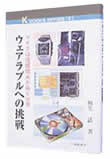| Japanese / English | |
HOME >> Nature Interface 2001.3: >> Book Review
|
||||||||||
|
||||||||||
Book Review (1/1)

Wearables in the 21st Century. KIYOSHI ITAO Kogyo Chosakai Publishing Co., Ltd., Jan.2001 Wearable information instruments have been used in Japan since olden times. Small portable abaci, which could be put in the bosom of a kimono or hung on the waist, and yatate, a small pencil case, which were also regarded as memory devices, are some examples. (Note: A yatate was a cylindrical case used to carry a brush and ink. Japanese people used to write using brushes in olden times. A brush was kept in the cylinder, and ink was installed on the top, so that people were always ready to write, especially when they traveled.) However, wristwatches may be the first item that can be called true wearable information instruments. Watches have evolved from sundials, clepsydrae, incense watches, etc. into mechanical watches which consist of a running gear with a spring, and a speed control device with a pendulum. Watches that were small enough to carry in a pocket were invented, and wrist watches were eventually developed. These bracelet-type watches are very convenient to use, and can be said to be one example of a typical wearable information instrument. The size of wrist watches has been getting smaller and smaller, approaching the limits of miniaturization, due to such great technologies as quartz movements, low-power operated LSI's, liquid crystal displays, high performing batteries, stepping motors, tiny cogwheel transmissions, and so on. Obviously, watches can tell us the hour, but they have also become multimedia information terminal units, with the ability to measure blood pressure, pulse rates, and calories, display telephone numbers, and receive FM modulated information (useful to businesspersons), and so on.. As can be seen with the evolution of watches, people came to be able to use information when they wanted to through the minimization of information devices with the functions of calculating, memorizing, communicating and photographing. These devices have gradually evolved from being information receivers to information senders. They can be used as tools to manage human healthcare and its distribution, and as monitoring systems of the natural environment and wild animals. In the future, these devices are going to be used as tools of "nature interface." Another use for wearable information instruments is expected to be as biological network systems complementing human sensory messages. "Wearable" means "able to wear comfortably and unconsciously outside the human body," but wearable information instruments today are evolving into intra-body devices that can offer information or order something for us. Many pacemakers have already been used in this manner, and an automatic hormone secretion system is going to be realized in the near future. For those losing their eyesight, an eyesight complementary system is being developed that involves implanting electrodes in the lobus occipitalis cerebri, that can transmit the information from a compact TV to the brain, and stimulate visual sensation. Artificial arms and legs are also being developed that can move by weak electric currents flowing from amputated sections through nerves. In other fields, the realization of comfortable space is expected to be developed by monitoring natural information, such as the degree of purity of oceans and rivers, the changes in terrestrial magnetism and the gap in strata aberration, and by monitoring human information derived from human feelings and health. Moreover, a new information technology industry is now under construction, by which we can receive and manage a lot of information. A GIS service with various information on buildings and underground shopping areas, which would be accessible by a combination of internet access, wearable devices and sensors, and a management service for agriculture, industry, transportation and distribution, are some examples. As mentioned above, wearable information instruments have been extensively developed in various fields, and are going to be extensively improved in the future. The author has developed micro information terminals, and, in this book, will present the history, the present state, related technologies, and future promising prospects of these information devices. In a sense, wearable information instruments are deeply related to all sorts of fields, and so there must be many readers who will be interested in this book. Wearable information instruments draw from, and are applicable to, many different fields. Read on to discover more about these exciting devices. (1/1) |
|Top of this Page|
©2000-2001 Nature Interface. corporation allrights reserved
